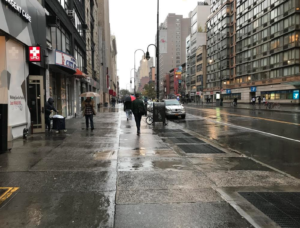
Viewing Performance Artist Pat Oleszko on 14th Street in “Caged Migration”
Walking under sidewalk scaffolding
between 3rd Avenue & Irving Place,
I witness a lofty woman
wearing a mop of red plastic hair
& wrapped in a blue plastic dress
covered by chicken wire mesh
with numerous legs—dangling from beneath—
shoed feet gently tapping on the pavement.
I’m taken aback by the unexpected
sight—as my mind is suddenly
captured by this absurd scene.
The unusual cartoonish image
soon transports me from horn-honking
Manhattan, to the Texas/Mexico border
as a face through ribbon-like strands
emerges, exposing unbearable grief.
The statuesque figure before me
bends in a slow painful rhythm
with a lone clarinet mournfully
playing sounds of sorrowful
sadness, prompting the larger than life
female—to writhe in a ghostly trance
of great suffering. Her lithe arms
slowly push against steel construction
bars—to no avail, becoming a prisoner
instead of a welcomed refugee
fleeing gang war in Central America.
A theatrical spectacle, conjuring
guilt inside myself, wondering if
I’ve made enough effort
to denounce the U.S. Government
for the horrendous crimes
against humanity—paid for by tax dollars
& ordered by a monstrous President
supported by Nationalist bigots & fools.
Like most pedestrians, I curiously glance
& depart from the metaphorical lady
cruelly separated from her offspring—
being kept in a locked cage indefinitely.
In my muddled head, I’m challenged
with reflective moments of contemplation
by the power of art in odd places.


